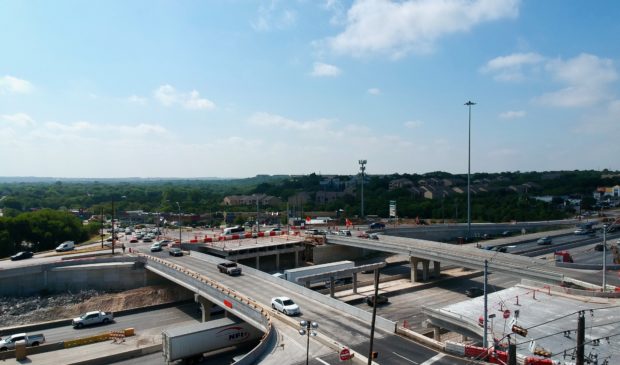CAMPO 2040 plan, Stassney Lane overpass highlight common failures of multimodal projects
Tuesday, December 3, 2019 by
Ryan Thornton A recent brief from the Center for American Progress suggests the Austin region’s transportation efforts may ultimately work against its own stated priorities.
Kevin DeGood, CAP’s director of Infrastructure Policy and author of the Nov. 13 brief, examined the Capital Area Metropolitan Planning Organization’s 2040 Regional Transportation Plan as well as details of the Texas Department of Transportation’s overpass project at Interstate 35 and Stassney Lane. Despite their stated multimodal ambitions, DeGood concluded that both attempts to improve mobility represent “all-of-the-above strategies” that actually induce more driving and increase automobile dependence.
“Due to both practical and political pressures, many metropolitan regions and state departments of transportation have grudgingly adopted what is known as an all-of-the-above strategy,” DeGood said. “An all-of-the-above strategy often uses smart growth rhetoric without the concomitant project investments that would usher in real change.”
Smart growth is an approach to transportation and land use that aims to prevent sprawl by promoting compact, walkable communities as opposed to low-density, car-dependent development.
Earlier this fall, city and state leaders joined the Austin Chamber of Commerce to undermine old antagonisms between public and private transportation and promote the idea that transit and roadway expansions can both be part of a regional mobility solution.
During the summit, the Texas Department of Transportation presented its I-35 Capital Express Project, the Capital Metropolitan Transportation Authority promoted its regional transit vision for Project Connect and the chamber called for an “all-of-the-above” solution embracing both projects and more.
That type of strategy, DeGood said, leads to “jarring modal juxtapositions and a perpetuation of the status quo.” True smart growth, on the other hand, requires a fundamental shift toward “inclusive communities that occupy less land and consume fewer fossil fuels while improving safe, affordable access to employment, social services and community amenities.”
Studying CAMPO’s 2040 Regional Transportation Plan, DeGood noted the contradiction between its many “laudable goals” like reducing vehicle miles traveled and the Transportation Policy Board’s commitment to considering all modes of transportation, including road capacity expansions, to reach those goals.
“And yet, certain investments are incompatible with others,” DeGood said. “For example, expanding the Austin area roadway network is antithetical to minimizing air pollution and energy consumption related to the transportation system and reducing (vehicle miles traveled).”
Last month the CAMPO board received a presentation on the 2045 Regional Arterials Concept Inventory, a $1.5 million study that proposes several possible future scenarios. The inventory calculated the likely impact to regional mobility if the agency were to expand the arterials network by as many as 6,000 added lane miles. The board will be considering such expansion projects with adoption of the 2045 Long Range Plan in May 2020.
As part of the ongoing I-35 improvements, DeGood studied the state’s Stassney Lane overpass project. With the inclusion of sidewalks and a bike lane, he said, the project is a “multimodal win” by historical standards. Upon closer inspection, however, he noted that specific design elements indicate that “the true purpose of the project is moving more cars and that cyclists and pedestrians are highly unlikely to use these elements with any meaningful frequency.”
A major tell, he said, is the inclusion of slip lanes that allow vehicles to make right turns at higher speeds than would be possible at a 90-degree angle. This design, he explained, is “intended to slingshot cars making right turns at high speeds, creating a severe safety risk for any pedestrian trying to walk through the corridor.”
DeGood notes that, despite the inclusion of sidewalks and bike lanes, the state’s own “Guidelines for Applying Right-Turn Slip Lanes” acknowledge that these often increase speeds and create conflicts between motorists and those walking or riding bikes.
DeGood criticized other design elements, too – the large gap between the sidewalk on the bridge and the turnaround bridges, narrow bike lanes and massive, car-oriented scale of the project – for adding to the hostile environment that will deter pedestrians and cyclists.
“If TxDOT were serious about encouraging nonmotorized users, it would implement changes designed to increase safety – such as eliminating the slip lanes, reducing crossing distances by extending the sidewalk closer to the travel lane, and slightly elevating the pavement within the marked crosswalk – rather than introduce slip lanes,” DeGood said.
DeGood estimated that the $78.8 million spent on the Stassney Lane project could have done much more for multimodal transportation if used in other ways; for example, based on average costs, it could have paid for over 100 miles of new sidewalks in the city.
The Stassney Lane overpass is scheduled for completion in early 2020.
“Loud and unsafe spaces that are built for cars will not attract pedestrians, cyclists, and public transit riders, as evidenced by the Stassney Lane project,” DeGood concluded. “Achieving meaningful mobility choice and building sustainable, inclusive communities require substantially deeper changes to the transportation and land use systems.”
Photo of Stassney Lane project courtesy of TxDOT.
The Austin Monitor’s work is made possible by donations from the community. Though our reporting covers donors from time to time, we are careful to keep business and editorial efforts separate while maintaining transparency. A complete list of donors is available here, and our code of ethics is explained here.
You're a community leader
And we’re honored you look to us for serious, in-depth news. You know a strong community needs local and dedicated watchdog reporting. We’re here for you and that won’t change. Now will you take the powerful next step and support our nonprofit news organization?









